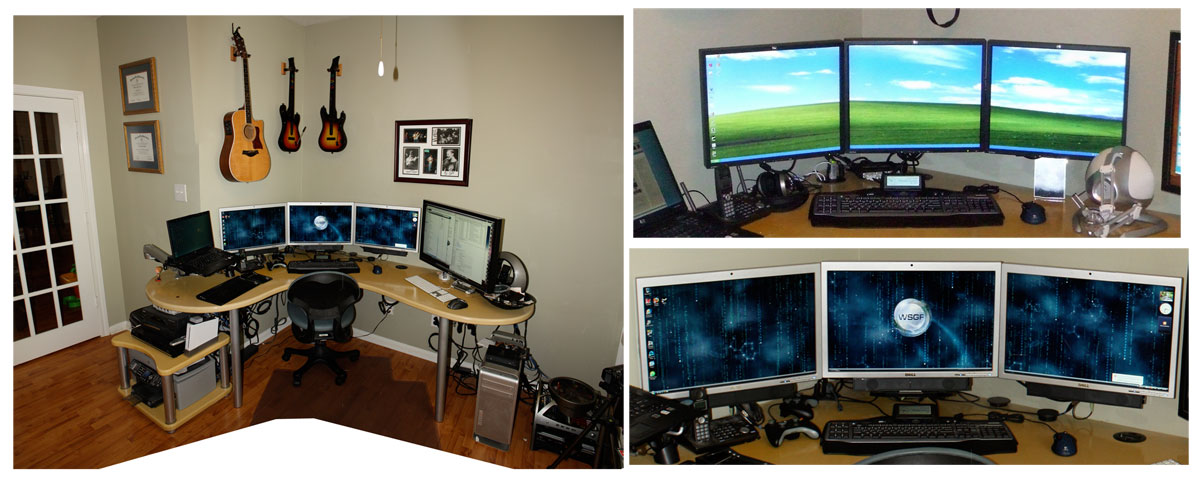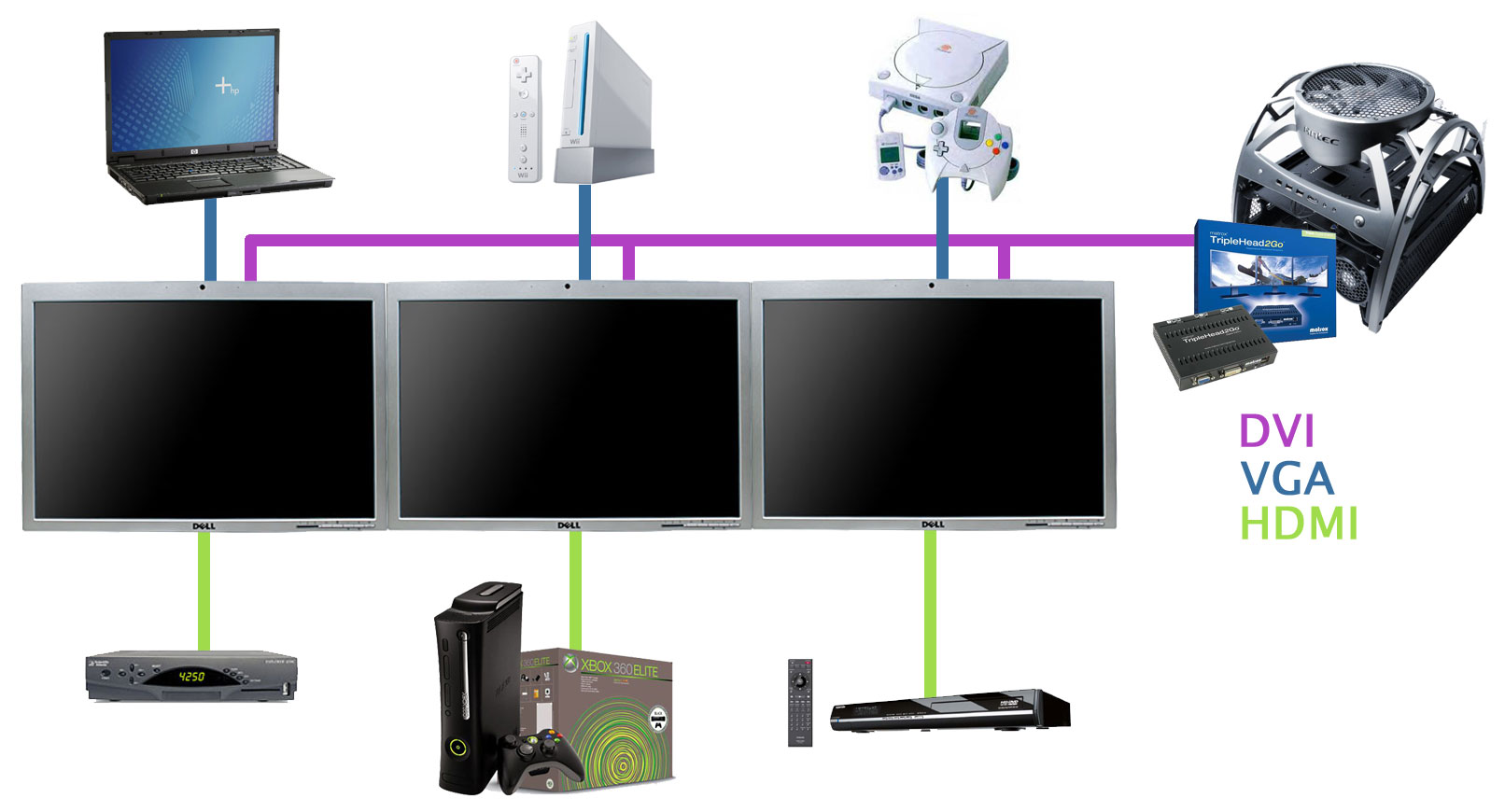Matrox TripleHead2Go Digital Edition New Widescreen Modes Review
First of all, I would like to extend my apologies to Matrox and the readership of the WSGF. The updates to support the Widescreen Surround modes came out over six months ago, and I am just now able to get this review completed. First was my saga with ASUS and my set of VW198T's. Three months and ten monitors later, I finally gave up and started over with three new monitors from Dell. Mix that with the aftermath of Hurricane Ike, Christmas and overhauling my gaming rig (and don't forget day job, the wife and the three kids), and I'm just getting this up.
That being said, I think some of the time has been beneficial to my experience. Not only have I been able to put in quality time with the hardware, but in that time Matrox has made significant strides in its software support. And, we've been able to get our hands on beta software that fixes many of the issues experienced in Vista. Again, my apologies for the delay; but I hope it's been worth it.
This review should be considered third in a series. The first two are Paddy's reivew of the original TripleHead2Go and my review of the TripleHead2Go Digital Edition. If this is your first exposure to the TripleHead2Go or Surround Gaming, I would strongly advise that you read the first two reviews - especially the TripleHead2Go Digital Edition. This is a review of the new enhanced widescreen modes of the TripleHead2Go Digital Edition (DTH2Go), and builds upon that original review.
The recent firmware and software update to the DTH2Go adds two new resolutions - 5040x1050 (3x1680x1050) and 4320x900 (3x1440x900). These new resolutions add significant functionality and capability to the DTH2Go, and are a very welcome addition. This update is only available with the DTH2Go, and not with the original analog model. The USB connectivity of the DTH2Go allows for user-implementable firmware updates.
I am hoping to get a video review done soon. I didn't want to delay publishing the print review any longer, so will be updating this space once the video review is finished.
New Widescreen Resolutions
The recent enhancement to the DTH2Go brings support for the next two major resolutions: 3x1440x900 and 3x1680x1050. The DTH2Go previously supported 3x16:10, but only at low resolutions such as 3x1280x800. These resolutions were not very enticing to users. The only panels to offer native 1280x800 were small 15" panels. Otherwise, users would be required to stretch the 1280x800 image across something larger, such as 1680x1050 (considering that 1440x900 panels are uncommon). Additionally, the limited vertical height of 800px often meant that the onscreen HUD took up large portions of the screen real estate.
The inclusion of 3x1440x900 or 3x1680x1050 allows users to invest in "mainstream" panel sizes such as 20" or 22". Additionally, users can opt for 24" panels, and scale the 1680x1050 image across the native 1920x1200. The scaling of 1680x1050 over 1920x1200 is far less obtrusive than 1280x800 over 1680x1050. Panels in the 20" or 22" range can now be found for ~$250, far less than when the DTH2Go originally shipped.
The DTH2Go does not support 3x1920x1080, 3x1920x1200 or higher. This is due to the bandwidth limitations of the Dual-Link DVI interface. Any enhancements there will require new hardware built upon something like HDMI or DisplayPort. The DTH2Go now supports the following TripleHead resolutions:
| Standard Resolutions | Widescreen Resolutions | ||||||
| 3 x 5:4 | 3 x 4:3 | 3 x 16:10 | 3 x 16:9 | ||||
| 1280x1024 | 3840x1024 | 1280x960 | 3840x960 | 1680x1050 | 5040x1050 | 1360x768 | 4080x768 |
| 1024x768 | 3072x768 | 1440x900 | 4320x900 | 1280x720 | 3840x720 | ||
| 800x600 | 2400x600 | 1280x800 | 3840x800 | ||||
| 640x480 | 1920x480 | 1280x768 | 3840x768 | ||||
| 800x480 | 2400x480 | ||||||
Widescreen = Greater Functionality
Moving from 5:4 to 16:10 monitors offers a number of advantages. The primary advantage is that the user now has the best of both worlds. Previously with the DTH2Go, it was an all or nothing proposition. You were able to play games in Surround or 5:4 (1280x1024) - nothing in between. Now, the user has the advantage of also being able to play games at 1680x1050 widescreen. So, if a games does not support Surround, or is Vert- (which essentially breaks Surround gameplay), the user is now able to enjoy the game in "normal" widescreen.
Additionally, the increased size of the monitors serves to further enhance the immersion. Three 19" 5:4 panels average about 45" across. Three 22" 16:10 panels stretch out to a total of 60" on the diagonal. While this still doesn't completely fill my peripheral vision, it comes very closes. Finally, having a 20" or 22" widescreen places the middle bezels outside the center focus of your vision. While the bezels on my 19" panels were never a large distraction; they are now even less so. Even with silver bezels on my current monitors, they "disappear" quite easily. Also, utilizing widescreen displays allows the user to watch widescreen HD content maximized on one screen (via disk, download or stream), while working or surfing on another.
The left-hand picture is my new setup with the widescreen monitors installed. For comparison, the single panel on the right is 30". The right-hand pictures compare the physical size difference of the 3x19" and 3x22" panels.

I use one of the monitors as a secondary display with the laptop for my day job. This wasn't feasible with the 19" displays, as their native 1280x1024 didn't match up with the 1680x1050 of my laptop. I was forever resizing windows as I moved them back and forth, and Windows often had issues with the difference as well. I'm now have double the work area, and have become much more productive and efficient in my multitasking. I'm actually considering a second TripleHead2Go, so that I could expand my work environment across the internal laptop display and three additional screens (over the VGA connections). I've found that the productivity argument for the TripleHead2Go is just as strong as the gaming argument.
Finally, moving to widescreen monitors will generally offer HDCP support, and additional connection types such as component and HDMI. These additional connections allow the user to hook up additional devices such as HD-DVD/Blu-Ray players, HDTV Cable Box, Xbox360 or PS3. I've found that I often watch TV on one of the monitors (through the HDTV Cable Box), or stream a Netflix movie with the Xbox 360, while working at night (either on the laptop for the "day job," or on my Mac to update the WSGF or edit video). While this may seem like a small capability, these additional features have allowed me to get significantly more use out of my monitors.
I am using all nine inputs on my monitors. The DVI inputs are connected to the TripleHead2Go. The HDMI inputs are connected to an HDTV cable box, an Xbox 360 Elite, and a Toshiba HD-A3 HD-DVD player. The VGA inputs are connected to my work laptop (extending my WinXP desktop, as described above), a Nintendo Wii (via the VDigi VD-W2 Wii VGA cable), and a Sega Dreamcast (through a DC VGA Box). The monitors use 1:1 aspect scaling for the DTH2Go and the Xbox 360 (thanks to 1680x1050 support in the NXE Dashboard update); 16:9 scaling for the HDTV, HD-DVD and Wii; and 4:3 scaling for the Dreamcast.
Additionally, I have sound bars on each monitor. With a couple of splitters, I am able to route audio signals from every device. For my gaming PC, I am routing the left and right signal to the left and right monitors, while routing the center channel to the center monitor. I am also running the sub signal to a JBL Radial that sits on my desk. So with the Widescreen Surround visuals, I am also getting 3.1 Surround audio.
This kind of setup wouldn't have been possible without the new Widescreen Surround modes on the DTH2Go allow me to place widescreen monitors at the center of my rig design. My Surround setup is now the center of a true multimedia hub.

